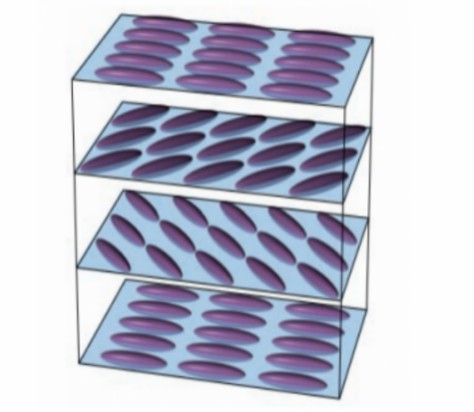Cholesteric Liquid Crystals
Cholesteric liquid crystals (CLC) have a helical structure, and generally by changing the pitch, they exhibit different properties. They are widely used in optical display, measurement detection, etc.
Introduction
Cholesteric liquid crystal molecules are flat and arranged in layers. The molecules in the layers are parallel to each other, and the long axis of the molecules is parallel to the plane of the layer. The direction of the long axis of the molecules in different layers changes slightly, and they are arranged in a spiral structure along the normal direction of the layer, as shown in Fig 1. The distance between the two parallel layers is called the pitch, and the length is several hundred nanometers, which is in the same order of magnitude as the wavelength of visible light.
 Fig 1 Schematic diagram of cholesteric liquid crystal molecules
Fig 1 Schematic diagram of cholesteric liquid crystal molecules
There are two formation processes of cholesteric liquid crystals. The first is that the cholesteric liquid crystal molecules themselves have chiral carbon atoms or other asymmetric chiral groups; the second is to dope nematic liquid crystals with chirality. It can generate the helical photonic structure of CLC.
Applications
- LCD temperature measurement
Through certain process techniques, only temperature-sensitive cholesteric liquid crystal materials can be obtained. Each color that this liquid crystal presents in a specific temperature range corresponds to a certain temperature, that is, different colors respond to different temperatures. Cholesteric liquid crystal temperature measurement has been applied in heat conduction nondestructive testing, flow field temperature measurement, fatigue inspection, electrical defect inspection, clinical inspection and so on.
- Smart window field
By adjusting the external environmental parameters (such as temperature), the pitch of cholesteric liquid crystals can be changed, and then the light of a certain wavelength band can be selectively passed and the light of other wavelengths can be blocked. If the reflected light band of the cholesteric liquid crystal is set in the infrared region, it can prevent the entry of infrared rays, thereby realizing the function of lowering the room temperature.
- Advanced photonics devices
The special helical structure of cholesteric liquid crystal makes the crystal have special optical properties such as obvious optical rotation and circularly polarized light dichroism. External field stimulation (such as light field, electric field, etc.) can realize the rearrangement of molecules, the construction, unfolding and reorganization of assembled microstructures, such as the pitch, helical chirality and the direction of the helical axis, etc., so as to obtain reversible, dynamic modulation of optical components and systems[1].
Reference
- Light propagation in cholesteric liquid crystals: the role of chirality[J]. Guo Tianyi, Zheng Xiaoyu,Palffy Muhoray Peter. Molecular Crystals and Liquid Crystals. 2021 (1).

![4-Pentyl-4'-Propyl-[1,1'-bi(cyclohexane)]-4-carbonitrile](https://resource.bocsci.com/structure/2757730-48-4.gif)



